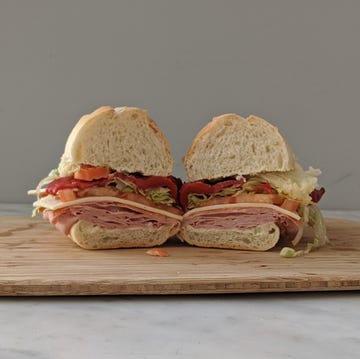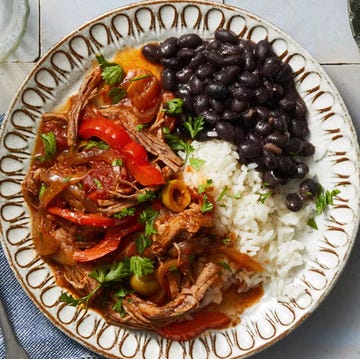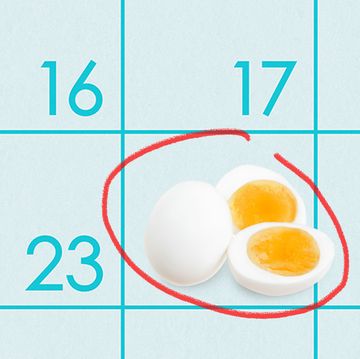How to Cook Dried Beans the Traditional Way
These easy steps will give you a perfect pot of stovetop beans, every time.

A can of beans is a glorious thing. The convenience, the ease, the nutritional value, oh my! But if a can of beans is great, learning how to cook dried beans (a whole pot of them!) might be even better. It's the perfect option for make-ahead dinners — and once you know how to cook them, you're armed with this knowledge for delicious meals any day of the week. Dried beans, when cooked properly, turn impossibly creamy on the inside with a sturdy exterior that provides the perfect, protein-packed bite.
Beans are not only one of the healthiest things you’ll find in the grocery aisle, they’re also one of the least expensive. Dried beans are usually cheaper than canned, and you can serve enough for the whole family at one time. The potential of a dried bean is truly boundless — and beyond tasty.
How long do I soak dried beans? Is it necessary?
The answer to whether or not you should soak dried beans is yes … and no. Soaking beans helps dissolve starches that can cause intestinal discomfort. Plus, it reduces cooking time and helps the bean cook more evenly.
But here’s a little secret — soaking beans is not totally necessary. You can cook unsoaked beans to yield similar results, but you’ll just have to add an hour or two to the total cooking time.
The easiest way to soak beans is to throw 'em in a pot, cover them with water, and let them sit, covered, in the refrigerator overnight. We know, the hardest part of this method is remembering to do it. Luckily, you’ve got other options: speed up the soaking process by covering the dried beans with water, bringing the water to a boil for 2–3 minutes, turning off the heat, covering the pot, and letting the beans soak for at least an hour and up to 4 hours. After that, just drain the beans and they’re ready to cook.
What is the best cooking method for beans?
We’re partial to the traditional method of cooking dried beans (soak overnight, simmer in a pot the next day) but if you’re short on time or want other options, we’ve got you covered.
Slow: Slow Cooker Method
Got a long, lazy Sunday with nothing to do? Try cooking your dried beans in a slow cooker for a hands-off method that yields tender, evenly cooked beans. Since the beans will hang out in the slow cooker for several hours, you don’t need to soak them first. Just rinse them, add them to the slow cooker with water, salt, and other aromatics, then cook on low for 3–6 hours.
Faster: Traditional Method
Call us old-fashioned, but cooking dried beans in a good ol’ pot on the stove gives you the most control over the end result. Add your dried beans to a large pot, cover with water and bring to a boil. Reduce the heat, cover, and keep the water at a gentle simmer until the beans are cooked through. Take a peek at your beans as they near the end of the cooking time to test for doneness (aka: tender, creamy perfection). Smaller beans that have been soaked can cook in as little as 45 minutes, and larger beans can take up to 2 hours. Let them cool in their cooking liquid to absorb maximum flavor.
Fastest: Pressure Cooker Method
For the least patient among us (we hear you!), an electric pressure cooker such as the Instant Pot is the best way to turn this pantry staple into weeknight dinner magic. Place your beans in a pressure cooker and cover with water; be sure not to go over the max quantity line. Add salt and other aromatics. Cook at high pressure for anywhere between 20–40 minutes depending on the size of the bean and whether or not you soaked them first. Allow the pressure to release naturally and drain right away.
Uh ... when do I add salt?
Beans are like little blank canvases with the potential for a masterpiece of flavor. Add herbs, spices, and other aromatics (garlic! chiles! rosemary! thyme!) at the beginning of cooking for the best flavor benefit.
When it comes to salt, be patient before adding a dash (or five). Unless you’re using a slow cooker or pressure cooker, wait to add salt until the beans are starting to get tender (as in, you can bite them without breaking a tooth but they’re not completely cooked through). This usually happens about halfway through the cooking time. Adding salt at the beginning can toughen the bean, which is the exact opposite texture we’re going for. After the beans are cooked and you turn off the heat, add more salt to taste and any acidic foods like lemon juice, vinegar, or tomatoes.
Oh, and save that cooking liquid. It creates a rich stock that freezes well and can be used just like chicken stock in future recipes. Yep, you just got two meals in one.
Ingredients
- 2 cups
dry beans
- 6 cups
water
- 4
cloves garlic
- 1
small onion
- 8
black peppercorns
- 2
bay leaves
Fresh herbs, optional (such as parsley, thyme, or anything you have on hand)
- 1
piece cheese cloth and twine or thread
Kosher salt and pepper
Directions
- Step 1Rinse the beans: Place the beans in a colander set in a bowl. Pick out and discard any pebbles or pieces of dirt, then run under cold water to rinse. Set the colander in a bowl of water and discard any beans that float to the top (these might have air pockets where dirt or mold exists).
- Step 2Soak the beans: we like an overnight soak, so place the beans in a container, pot, or whatever you have room in the fridge for, and cover with at least 3 inches of water.
- Step 3Cooking the beans: Place soaked beans in a large saucepan and cover with 6 cups water. Smash the garlic and quarter the onion and place both in the center of a piece of cheese cloth. Add peppercorns, bay leaves, and any fresh herbs, if using. Gather the corners together tie everything up to make a bundle (or purse) and add to the pot.
- Step 4Bring the beans to a slow simmer, partially cover and simmer, stirring occasionally, until the beans are tender, 1½ to 2 hours. If at any point you see any beans peeking through the liquid, add enough hot water to cover by ½ inch (without enough water, they could stick to the bottom or not cook evenly).
- Step 5Remove and discard the cheesecloth bundle and strain the beans, reserving the liquid. You can use this starchy liquid in soups, to thicken sauces and in stews. The beans are ready to be seasoned and eaten or to use in other recipes.

Make All Your Sandwiches Better With One Trick

11 Essential Pantry Staples to Stock Up on Now

The Biggest Air Frying Mistake

How to Freeze Cheese







